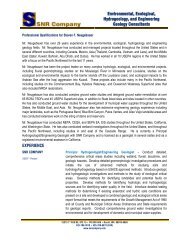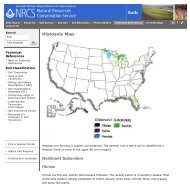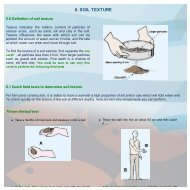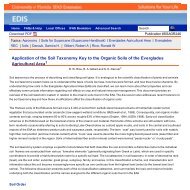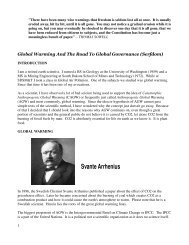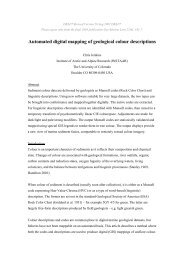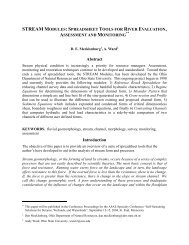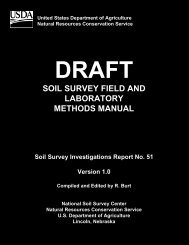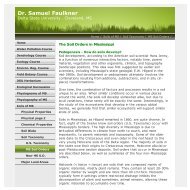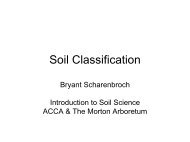chapter 3 fundamentals of fluvial geomorphology and stream ...
chapter 3 fundamentals of fluvial geomorphology and stream ...
chapter 3 fundamentals of fluvial geomorphology and stream ...
Create successful ePaper yourself
Turn your PDF publications into a flip-book with our unique Google optimized e-Paper software.
Figure 3.4 – Typical Plan <strong>and</strong>Cross-sectional Views <strong>of</strong> Pools<strong>and</strong> Crossings (FISRWG 1998)Bars are depositional features that occur within the <strong>stream</strong>.The types, sizes, frequency <strong>of</strong> occurrence, <strong>and</strong> locations <strong>of</strong> barsare related to the quantity <strong>and</strong> caliber <strong>of</strong> the sediment load, localsediment transport capacity, <strong>and</strong> morphology <strong>of</strong> the reach. Themost common types <strong>of</strong> bars are point bars, middle bars, <strong>and</strong>alternate bars.Point bars form at the convex bank <strong>of</strong> bends in ame<strong>and</strong>ering <strong>stream</strong> (Figure 3.5). The size <strong>and</strong> pr<strong>of</strong>ile <strong>of</strong> the pointbar are influenced by the characteristics <strong>of</strong> the flow, degree <strong>of</strong>sinuosity, <strong>and</strong> the quantity <strong>and</strong> caliber <strong>of</strong> the sediment deposited atthe bend. The development <strong>of</strong> a point bar is driven by reduction inthe sediment transport capacity at the inner bank <strong>and</strong> sedimentsorting due to the action <strong>of</strong> transverse flows <strong>and</strong> secondarycurrents (Dietrich et al. 1984), <strong>of</strong>ten coupled with flow separation atthe inside <strong>of</strong> the bend down<strong>stream</strong> <strong>of</strong> the apex (Leeder <strong>and</strong>Bridges 1975). Middle bar is the term given to areas <strong>of</strong>deposition lying within, but not connected to the banks. Middle barsin me<strong>and</strong>ering rivers may form at riffles, especially where thecrossing reaches between consecutive bends are long, <strong>and</strong> inbends due to the development <strong>of</strong> a chute <strong>stream</strong> that separatepart <strong>of</strong> the point bar from the inner bankline. Figure 3.6 shows atypical middle bar on the Mississippi River formed by this process.Alternate bars are regularly-spaced depositional featurespositioned on opposite sides <strong>of</strong> a straight or slightly sinuous <strong>stream</strong>(Figure 3.7a) <strong>and</strong> may be a precursor to me<strong>and</strong>er initiation orFundamentals <strong>of</strong> Fluvial Geomorphology <strong>and</strong> Stream Processes 27



